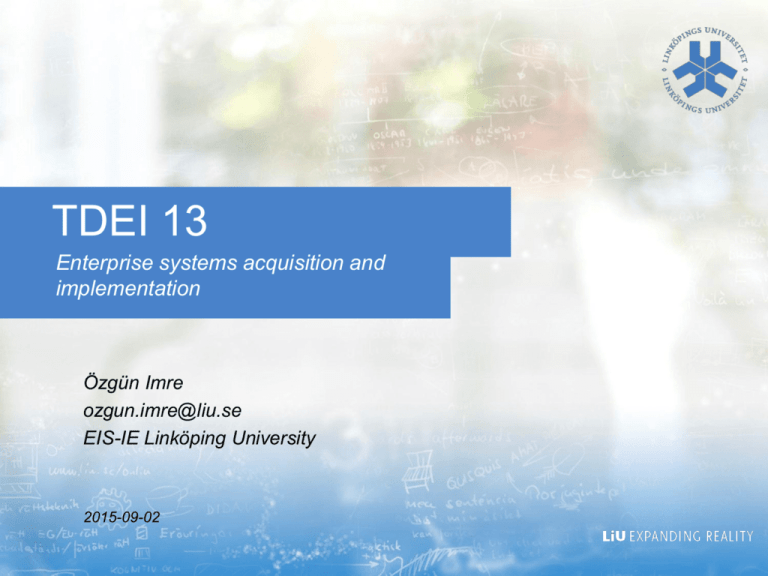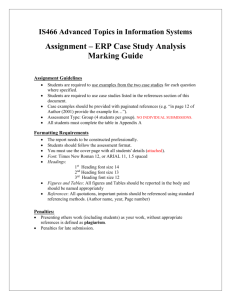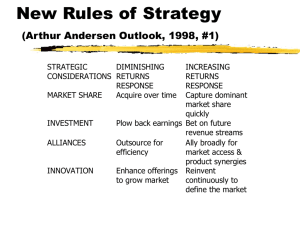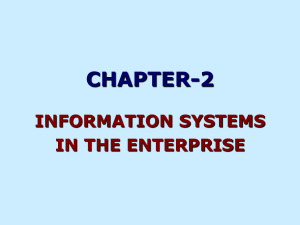slides
advertisement

TDEI 13 Enterprise systems acquisition and implementation Özgün Imre ozgun.imre@liu.se EIS-IE Linköping University 2015-09-02 Agenda • The ERP presentations • Some formalities around the course Rolls-Royce case Yusuf, Y., Gunasekaran, A. & Abthorpe, M.S., 2004. Enterprise information systems project implementation: A case study of ERP in Rolls-Royce. International Journal of Production Economics, 87(3), pp.251–266 Packaged Software Light, B., 2005. Potential Pitfalls in Packaged Software Adoption. Communications of the ACM, 48(5), pp.119–121. 2 Course Project • The purpose of the group projects is to give you an opportunity to encounter, second or first hand, views and impressions expressed by people who have been involved in ERP ventures. • Document studies • If possible: Interviews 3 Course Project • The final report: 4 • 10 - 12 pages of text (excluding executive summary and references). • Executive summary • A list of contents, • A clear purpose, • A review of relevant literature, • A section describing your second or first hand field study, • An analysis using the field study and the literature, • Conclusions relating to the report’s purpose, • A reference list with complete references to sources used. • Begin working as soon as possible • Don’t forget the milestones • Your group has to be present for the presentation days – if you can not show up you need to let me know before • If you have an assignment and you can not show up, you have to an extra assignment 5 Other date related issues Still no date for Qlikview The test is moved to 23rd We might have a study visit 6 The organisation? 7 A process perspective 8 Information flow and ERP system Sales Manufaturing Dokumentering Carry out order With ERP Accounting Dokumentering Write and control order Documents Documents Without ERP Distibution Deliver order Report a need Supply Invoice / payment Order Payment Supplier Deliver material Deliver a product Place an order Customer Sales Place an order Manufacturing Deliver of goods Distribution Payment Plan of manufacturing Order control 9 Transport Work systems 10 Alter, 2008 Packaged software • In good old times • In house software • Created for the company • Unique business processes mapped on • In-house IT people Today ? 11 Packaged Software 12 Potential pitfalls Reasons for purchase Expectation / pitfall Correction of existing problems Legacy systems and backlog Availability of a broader skills base Predictability Cost Perception of a reliable product Functionality Business benefits Freeing up the IS function Desire for standardization Implementing change Social influences Role of selling Bravado Why an ERP? The story goes: Today we are in a global economy, so we have increased competition We compete on more fronts than price and quality We need to be flexible, adaptable, agile, responsive We decided to decentralise (some of the operations) 14 Why an ERP? ERP as a part of the supply chain issues ERP as a tool for success (or at least solving problems) However, ERP is not just an IT implementation, it is a wide-ranging organisational change project 15 • integrate individual functional systems such as manufacturing, finance, procurement and distribution. • replace their existing information systems • standardise the flow of management information • Business process automation. Timely access to management information. Improvement in the supply chain via the use of ecommunication and e-commerce. 16 However… • Some of the companies that implement ERP systems do not realise the full benefits that the system offers because most organisations are not organised in the correct fashion to achieve the benefits. (p. 253) • This means that the organisation has to adapt to the system ! • ERP software is very adaptable but not very malleable and companies that wish to use them correctly have to change their working practices to fit the software. (p. 254) 17 Some common issues? • cultural problems • business problems (business process) • technical problems (data migration/entering) 18 The implementation model Some social worlds 19 Some complications • Inability to align goals • The non-delivery of reliable hardware • Failure of providing inadequate support • The resistance of change • The project treated merely as an IT implementation • Inadequately education of workforce • Inability to load data from old systems • Maintenance difficulties • Changes to kitting demand during go live may stretch the new system • Sustainability of the IS during the post-implementation period 20 www.liu.se 22 Some implications Social worlds/arena/negotiated order can provide a situated, dynamic analysis of issues Can complement the static view adopted in stakeholder analysis IS can play the role of the boundary object in such situations, and trigger the negotiations and learning Using such lens can help iron out differences to find a workable situation, and help out wider IS implementation problems 23 Venue 1 • Lots of combinations: would social worlds add to the stakeholder theory? • Would saying it will add dynamism just be a buzz word? • Are they the same? Or how can we identify the difference from a bunch of interviews? 24 Venue 2 • Negotiated order with stakeholder theory • Focus on temporality of the order, which is what dynamism is • Adds non-executives to the system • Would we see any difference between stakeholders and social worlds? Would we feel different if we talked to editor x, who is also the dean? 25









